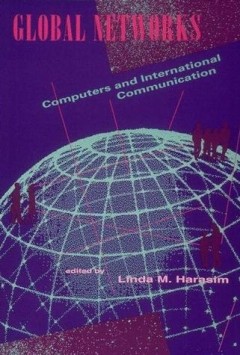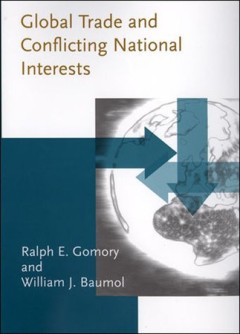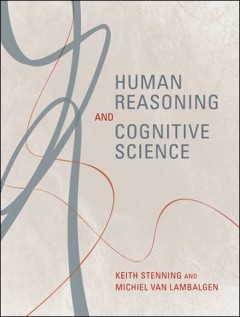Filter by

Global networks : computers and international communication
Global Networks takes up the host of issues raised by the new networking technology that now links individuals, groups, and organizations in different countries and on different continents. The twenty-one contributions focus on the implementation, application, and impact of computer-mediated communication in a global context. Previously limited to scientific research, global networks now have a…
- Edition
- -
- ISBN/ISSN
- 0585020361
- Collation
- 1 online resource (xii, 411 pages) :illustrations
- Series Title
- -
- Call Number
- 005 GLO

Global trade and conflicting national interests
Ralph Gomory and William Baumol adapt classical trade models to the modern world economy.In this book Ralph Gomory and William Baumol adapt classical trade models to the modern world economy. Trade today is dominated by manufactured goods, rapidly moving technology, and huge firms that benefit from economies of scale. This is very different from the largely agricultural world in which the class…
- Edition
- -
- ISBN/ISSN
- 9780262274050
- Collation
- 1 online resource (xvi, 199 pages) :illustrations.
- Series Title
- Lionel Robbins Lectures
- Call Number
- 380 GOM g

Globalization and History : the Evolution of a Nineteenth-Century Atlantic Ec…
Kevin O'Rourke and Jeffrey Williamson present a coherent picture of trade, migration, and international capital flows in the Atlantic economy in the century prior to 1914-the first great globalization boom, which anticipated the experience of the last fifty years.OCLC-licensed vendor bibliographic record.
- Edition
- -
- ISBN/ISSN
- 9780262294300
- Collation
- 1 online resource (346 pages)
- Series Title
- -
- Call Number
- 380 ORO g

A Burglar's life; or, The stirring adventures of the great English burglar Ma…
- Edition
- -
- ISBN/ISSN
- -
- Collation
- xxi, 194 p,Authorship uncertain. Editors regard James Lester Burke as probable author,First publishe
- Series Title
- -
- Call Number
- SRLF_UCLA:LAGE-782059
- Edition
- -
- ISBN/ISSN
- -
- Collation
- xxi, 194 p,Authorship uncertain. Editors regard James Lester Burke as probable author,First publishe
- Series Title
- -
- Call Number
- SRLF_UCLA:LAGE-782059

Quantified; Redefining Conservation For The Next Economy
Pendekatan konservasi yang inovatif dan berorientasi pada hasil, Disusun oleh pelopor restorasi sungai dan arsitek konservasi terukur, Strategi inovatif diambil dari perusahaan-perusahaan paling efisien, paham teknologi, dan sukses di dunia
- Edition
- -
- ISBN/ISSN
- 978-1-61091-615-8
- Collation
- -
- Series Title
- -
- Call Number
- 338.9 WHI q

Quality of Machined Wood Surfaces
1. Memberikan gambaran menyeluruh dan terperinci tentang kualitas permukaan kayu yang dikerjakan, 2. Meliputi banyak hasil dan representasi eksperimen baru, 3. Menawarkan konten yang berharga bagi para ahli dan praktisi penelitian ;;; Tujuan dari monograf ini adalah untuk mengkarakterisasi dan mendeskripsikan kualitas permukaan kayu yang dikerjakan, sedangkan perhatian khusus diberikan pada uti…
- Edition
- -
- ISBN/ISSN
- 978-3-319-22419-0
- Collation
- -
- Series Title
- -
- Call Number
- 674.2 CSA q

Creating Scientific Concepts
An account that analyzes the dynamic reasoning processes implicated in a fundamental problem of creativity in science: how does genuine novelty emerge from existing representations?How do novel scientific concepts arise? In Creating Scientific Concepts, Nancy Nersessian seeks to answer this central but virtually unasked question in the problem of conceptual change. She argues that the popular i…
- Edition
- -
- ISBN/ISSN
- 9780262280549
- Collation
- 1 online resource (xiv, 251 pages) :illustrations
- Series Title
- -
- Call Number
- -

Human Reasoning and Cognitive Science
"A Bradford book.""In Human Reasoning and Cognitive Science, Keith Stenning and Michiel van Lambalgen - a cognitive scientist and a logician - argue for the indispensability of modern mathematical logic to the study of human reasoning. Logic and cognition were once closely connected, they write, but were "divorced" in the past century; the psychology of deduction went from being central to the …
- Edition
- -
- ISBN/ISSN
- 9780262284295
- Collation
- 1 online resource (xii, 407 pages) :illustrations
- Series Title
- -
- Call Number
- -

Race and Entrepreneurial Success: Black-, Asian-, and White-Owned Businesses …
A comprehensive analysis of racial disparities and the determinants of entrepreneurial performance--in particular, why Asian-owned businesses on average perform relatively well and why black-owned businesses typically do not.Thirteen million people in the United States--roughly one in ten workers--own a business. And yet rates of business ownership among African Americans are much lower and hav…
- Edition
- -
- ISBN/ISSN
- 9780262272476
- Collation
- 1 online resource (x, 240 pages) :illustrations
- Series Title
- -
- Call Number
- -

At Your Service: Service-Oriented Computing from an EU Perspective
Presents results of collaborative research projects of the European Community's Information Society Technologies Programme about service-oriented computing.Service-Oriented Applications and Architectures (SOAs) have captured the interest of industry as a way to support business-to-business interaction, and the SOA market grew by $4.9 billion in 2005. SOAs and in particular service-oriented comp…
- Edition
- -
- ISBN/ISSN
- 9780262255080
- Collation
- 1 online resource (xii, 564 pages) :illustrations.
- Series Title
- -
- Call Number
- -
 Computer Science, Information & General Works
Computer Science, Information & General Works  Philosophy & Psychology
Philosophy & Psychology  Religion
Religion  Social Sciences
Social Sciences  Language
Language  Pure Science
Pure Science  Applied Sciences
Applied Sciences  Art & Recreation
Art & Recreation  Literature
Literature  History & Geography
History & Geography